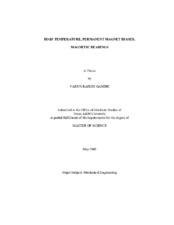| dc.description.abstract | The Electron Energy Corporation (EEC) along with the National Aeronautics and
Space Administration (NASA) is researching magnetic bearings. The purpose of this
research was to design and develop a high-temperature (1000�F) magnetic bearing
system using High Temperature Permanent Magnets (HTPM), developed by the EEC.
The entire system consisted of two radial bearings, one thrust bearing, one motor and 2
sets of catcher bearings.
This high temperature magnetic bearing system will be used in high
performance, high speed and high temperature applications like space vehicles, jet
engines and deep sea equipment. The bearing system had a target design to carry a load
equal to 500 lb-f (2225N). Another objective was to design and build a test rig fixture to
measure the load capacity of the designed high temperature radial magnetic bearing
(HTRMB) called Radial Bearing Force Test Rig (RBFTR).
A novel feature of this high temperature magnetic bearing is its homopolar
construction which incorporates state of the art high temperature, 1000 �F, permanent
magnets. A second feature is its fault tolerance capability which provides the desired
control forces even if half the coils have failed. The permanent magnet bias of the radial magnetic bearing reduces the amount of
current required for magnetic bearing operation. This reduces the power loss due to the
coil current resistance and also increases the system efficiency because magnetic field of
the HTPM is used to take up the major portion of the static load on the bearing. The bias
flux of the homopolar radial bearing is produced by the EEC HTPM to reduce the related
ohmic losses of an electromagnetic circuit significantly.
An experimental procedure was developed using the Radial Bearing Force Test
Rig (RBTFR) to measure actual load capacity of the designed bearing at the test rig. All
the results obtained from the experiment were compiled and analyzed to determine the
relation between bearing force, applied current and temperature. | en |


